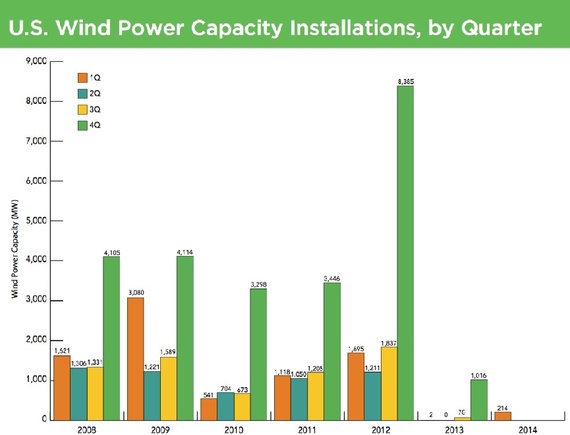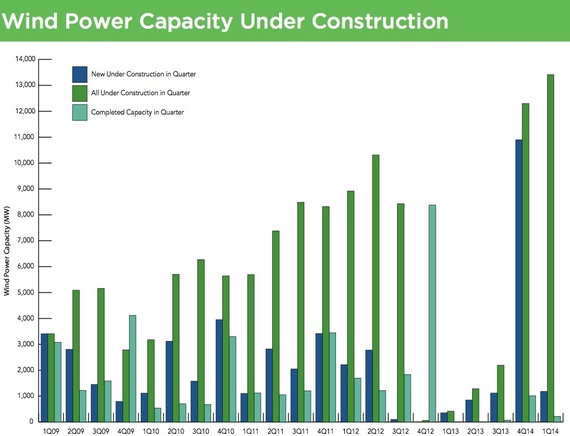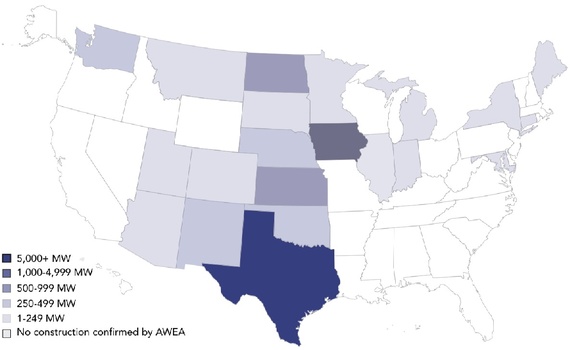The Crazy Economics of the Wind Industry in Two Charts
May 5, 2014 - Todd Woody - theatlantic.com
The wind business crashed in 2013, yet a record number of turbine farms are under construction in the U.S.

The news from the wind industry last week didn’t look good.
The booming business of minting money out of thin air had imploded between
2012 and 2013, as this chart from the American Wind Energy Association (AWEA)
shows.

According to the AWEA, a Washington, D.C.-based trade group, wind turbine
installations hit a record 8,385 megawatts in the fourth quarter of 2012
only to crash in the first quarter of 2013 to 1.6 megawatts—and,
yes, the decimal place is in the right place. In other words, thousands
of wind turbines went online at the end of 2012 to power about 2.1 million
American homes. Three months later, about one more turbine had been installed,
generating just enough juice to supply about 405 homes.
The downdraft continued in the first quarter of this year, according to
the AWEA, when 133 turbines producing 433 megawatts went online. That’s
certainly an improvement over the first quarter of 2013 but it's abysmal
compared with the first quarter of 2012, when 1,695 megawatts were installed.
Coal barons must be popping the champagne, right? Not quite. According to
this chart from the AWEA, a record 13,000 megawatts’ worth of wind
farms were under construction in the first three months of this year.

What gives? The United States Congress. Or more precisely, Congress gives
a lucrative tax incentive to the wind industry and then takes it away every
couple of years or so. The federal Production Tax Credit (PTC) pays wind
energy producers a 2.3-cent premium for every kilowatt-hour generated during
the first decade of a project’s operation. Uncertainty over whether
Congress would let the PTC expire at the end of 2012—it did—created
a lot of dead air as investors fled the industry.
Even though Congress got around to extending the tax credit in January 2013,
the damage was done. Manufacturers idled factories and laid off workers while
utilities signed contracts with other energy producers.
Congress only extended the PTC for another year but threw the industry a
bone when it allowed to the tax credit to be claimed as long as construction
began by the end of 2013. (In the past, projects had to be completed before
the PTC expired.) That explains the massive amount of megawatts under construction
in the first quarter of 2014.
Most ground was broken in 2013 and construction is carrying over this year.
One worrying sign: Only about 1,000 megawatts of new projects actually began
construction in the first three months of this year, most likely due to ongoing
uncertainty over the PTC’s future.
The big winner of the current building boom: Texas. More than 60 percent
of the 13,000 megawatts under construction in the first quarter of the year
is in a state denominated by climate change-denying politicians who, nevertheless,
have a soft spot for renewable energy and electric cars—hello, Tesla
gigawatt factory—if it means cold hard cash.

One bright spot: Big corporations like Google are stepping in to make big
wind energy purchases. Most recently, Mars—the candy conglomerate,
not the planet—announced last week that it would buy renewable energy
certificates associated with the entire electricity output of a 200-megawatt
wind farm under construction in—you guess it—Texas.